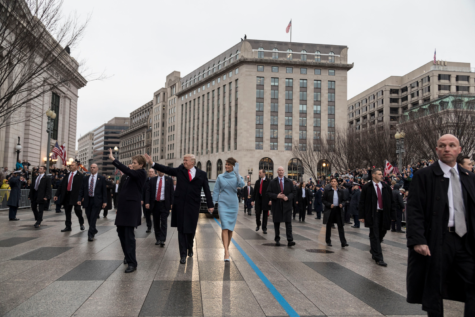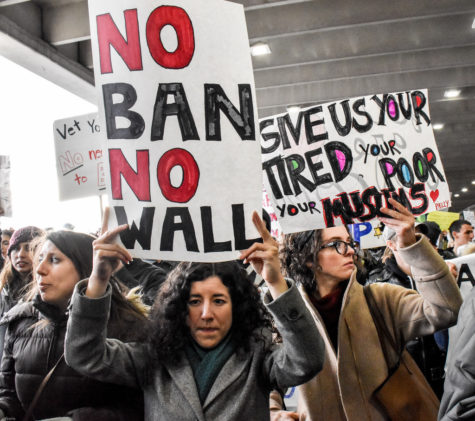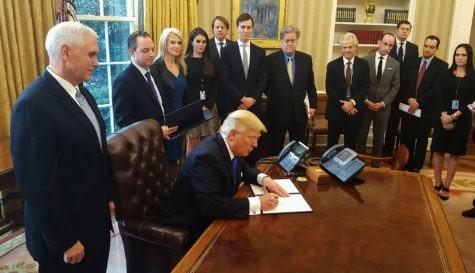
By, Meghan Serceki | Opinion Editor
May 3, 2017
Saturday, April 29, 2017 marks the hundredth day of Donald Trump’s presidency. Nearly a week prior to this landmark, Trump tweeted, “No matter how much I accomplish during the ridiculous standard of the first hundred days, & it has been a lot (including S.C.), media will kill!”
Although he dismisses it as a “ridiculous standard,” Trump promised his supporters many specific things by this time in his term. Not all of these promises, however, have panned out. Trump’s full 100 day plan is outlined in a twenty minute speech delivered in Gettysburg, Pennsylvania, but here are the most prominent of those points:
Build Mexican Border Wall:
Announcing his campaign, Trump promised to build a wall along the United States border with Mexico and to get Mexico to pay for it. On January 25, he signed an executive order for the construction of the wall, and the due date for contractors to submit designs of the wall was March 10.
However, questions remain over the funding of the project as the Mexican government refuses to pay, and opposition to the construction of it remains strong. As Trump awaited a government funding bill from Congress, a government shutdown loomed overhead. There were questions as to whether Trump would even approve a bill unless it contained funding for the wall. 
Enact a “Total and Complete Shutdown of Muslims Entering the United States”:
During his first 100 days, Trump signed two executive orders aimed at achieving this goal. He wanted to impose such a shutdown so as to give immigration officials time to develop an “extreme vetting process.”
Trump drafted these travel bans bans as a “protection of the nation from foreign terrorists,” temporarily suspending the entry of all people from “Muslim-majority nations” such as Iraq, Iran, Libya, Yemen, Sudan, and Somalia. Immediately, the ban met resistance from the courts and the American public.
Carmel Shahriary, a junior at San Clemente High School who spent part of her summer assisting refugees in Germany, insists these bans violate people’s right to freedom of religion, claiming, “These people are looking for peace and prosperity. The last thing they want is to hurt our nation.”
The two proposed bans were both blocked by federal judges under the pretense that they were “constitutionally incorrect.” Rudy Guiliani, one of Trump’s advisers, however, claimed, “What we focused on was, instead of religion, danger.” This was an attempt to circumvent allegations that such an order impedes upon people’s First Amendment Right to freedom of religion by claiming it a security measure rather than a religious one.
Pick New Member of The Supreme Court:
Success came for the Republicans in the naming of Neil Gorsuch as the next Supreme Court judge to replace the late Antonin Scalia.
Originally nominated by former President Barack Obama to fill the vacancy, Merrick Garland’s confirmation hearing was blocked by Senate Republicans hoping to save the seat for a more conservative judge.
With Trump’s election, he nominated the conservative Judge Neil Gorsuch, pleasing Republicans yet infuriating Democrats who felt Garland had the right to a hearing. Democrats threatened to make the confirmation of Gorsuch difficult, yet the Republican majority ensured his confirmation. He took the spot on the bench just a few weeks ago.
Lift Regulations on Fossil Fuel Industries:
Under the Obama Administration, the Environmental Protection Agency passed nearly 4,000 regulations. In his time as president, Obama enacted the Clean Power Plan, putting more focus on alternative energy sources; signed the Paris accord, working towards keeping global temperatures from rising dramatically in the coming years; set greater regulations on emissions, limiting greenhouse gas emissions nationwide and strengthening the Clean Air Act; and, among other things, amended the Clean Water Act to prevent mining companies from dumping tailings directly into water sources.
Mikayla Hartigan, also a Junior at SCHS, supports these governmental regulations, noting, “The environment is suffering from our actions and has been for over 700 years, and it is necessary to understand the repercussions of our actions and make changes in the future.”
Trump, however, within his first few weeks in office, nominated Scott Pruitt of Oklahoma to take over the EPA and proposed a budget to slash its funding by 31%. In late March, Pruitt issued a plan to lay off 25% of the agency’s employees. Pruitt, a long-time legal enemy of the organization he now runs, sued its measures under the Obama Administration 13 times, and hopes to deregulate many of the restrictions placed on the fossil fuel industries to encourage fracking and drilling.
Under Pruitt’s leadership, the agency removed the revision made to the Clean Water Act during President Obama’s term, again allowing direct contamination of freshwater by mining companies. On April 26th, Trump opened up a review of national monuments with hopes of opening up more federal land for drilling, mining, and the like. Similar legislation is yet to come.
Withdraw from the Trans-Pacific Partnership:
Within his first week in office, Trump abandoned the Obama-era Trans-Pacific Partnership, which he labeled one of the “ridiculous trade deals that have taken everybody out of our country and taken companies out of our country.”
The trade deal, not yet approved by Congress, proposed a complex trade network between the United States and countries like Japan, Canada, and Chile in hopes of creating ties with Southeast Asia to help compete with the industrial powerhouse China.
Trump, however, believes the deal lures companies from the United States and moves jobs to low-wage countries, favoring instead protective tariffs as part of his “America-first” policy. In spite of his criticisms of Obama’s plan, Trump has yet to come up with a comprehensive outline of his own.
“Totally Renegotiate” NAFTA:
The North American Free Trade Agreement, negotiated by Bill Clinton, allows free trade between the United States, Canada, and Mexico. Claiming it harms American workers by encouraging manufacturers to move to Mexico, Trump repeatedly expressed his desire to “totally renegotiate” the legislation, yet the implications of such actions remain unclear.
On April 27, Trump claimed, “I decided rather than terminating NAFTA, which would be a pretty big, you know, shock to the system, we will renegotiate,” agreeing only to terminate it completely should he be “unable to make a fair deal.” Of course, it is impossible to know what he considers a “fair deal,” so the future of the agreement still hangs in the balance.
Repeal and Replace the Affordable Care Act:
The Affordable Care Act, passed in 2010 and often referred to as “ObamaCare,” has provided 20 million previously-uninsured citizens with health insurance. It worked to improve the healthcare system and to make insurance more comprehensive and accessible, requiring insurers to cover things like mental health treatment and maternity care, preventing them from capping payments and from turning away patients with pre-existing medical conditions. In addition, it demanded that companies employing more than 50 people offer insurance to those working full-time.
However, many of its critics, like Trump, claim it makes premiums too high and denounce the idea of government intervention in the industry. With Republicans controlling both the executive and legislative branches, conservatives look to “repeal and replace” the act, yet find themselves troubled with how to do so.
Attempts to repeal the ACA have failed as Republican leaders have been unable to gain the necessary support or to draft a comprehensive replacement. Debates remain regarding which parts of the act to maintain and which to scrap altogether. Paul Ryan’s plan has failed so far to make it out of Congress, and the status of ObamaCare remains in limbo.
Reform Taxes:
Trump, hoping to lower taxes on the wealthy, proposed on April 26, 2017 a tax plan lowering the number of brackets to 3, with a maximum rate of 35%. In addition, he plans to get rid of the estate tax, allow corporations to make foreign profits without having to pay extra taxes, and expand the 15% corporate tax rate to other industries– making it possible for wealthy individuals to find loopholes and evade the higher individual tax rates.
Trump’s core group of supporters, blue collar white people, would not benefit from this plan, whose focus is primarily on the wealthy. The new tax plan, presented just days before his 100 day mark, has yet to be made into a reality.
Trump has made many promises, but is now learning the slow pace of government. A few days ago, he commented, “I thought it would be easier.” With over three years left in his term, he still has time to make changes, but questions remain about what these changes will look like and when they will come.

I respect this article and also I am glad we are bringing attention to Donald Trumps un-fulfilled promises :)))))